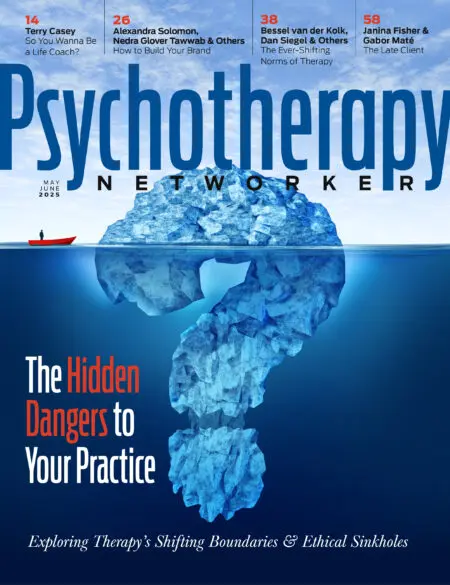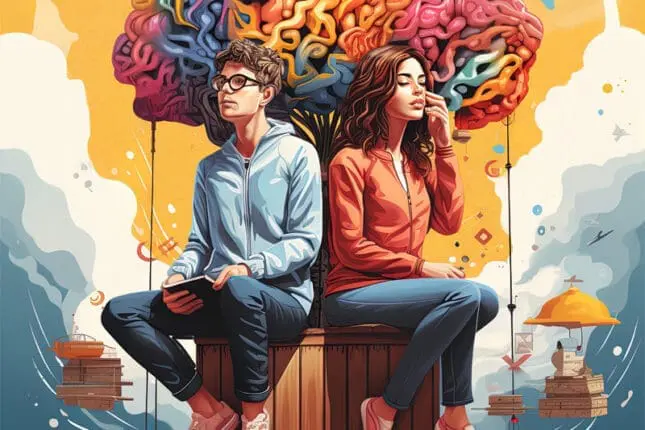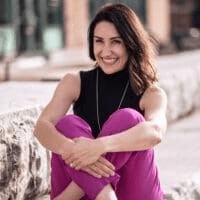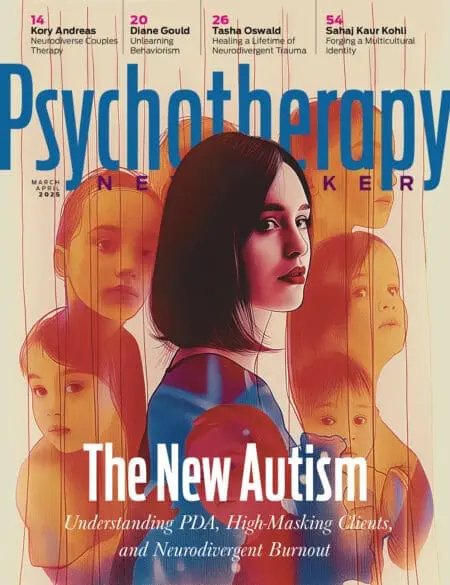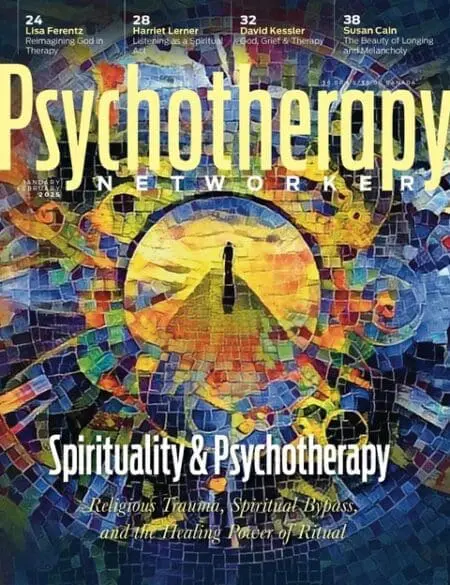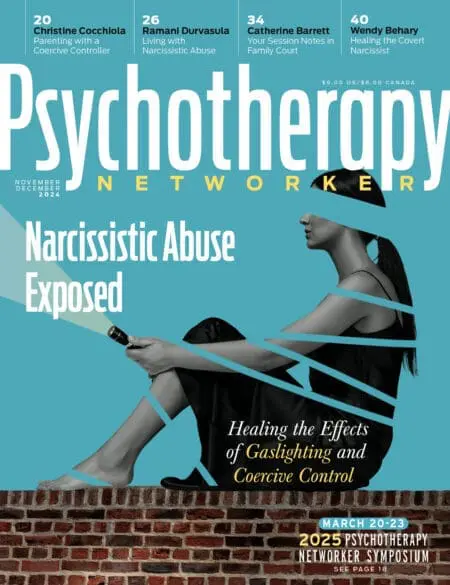I settle into the corner of my home office, a soft blanket on my lap, a warm mug of afternoon coffee in my hands, and a HIPAA-compliant pair of goldendoodles piled at my feet.
Despite the thunder booming outside the window, the three of us are ready for Kevin and Laura, one of many couples I see for neurodiverse couples counseling—a niche I developed after seeing how often traditional couples therapy fails to address the unique communication styles and needs of Autistic individuals and their partners.
Seated directly next to a colorful, floating bookshelf, I open my laptop to start the virtual session. The shelf is an optical illusion, leading you to think my favorite stack of autism-related books are effortlessly defying gravity. In actuality, the support is just underneath the last book, hidden and strong.
“How are your books levitating?” new clients sometimes ask. “Good accommodations” I smile. The shelf serves as a reminder that with the right kind of support, we can all defy the forces that weigh us down.
Kevin is a 35-year-old network administrator who sports a messy ponytail and an affinity for edgy, sarcastic t-shirts. He’s blunt, direct, and has a way of launching us into action at the start of each session. Laura is 40, soft-spoken, and works in the HR department of a big government agency. After seeing three different couples therapists in four years, Therapist #4, who suspected Kevin might be Autistic, recommended me. Six sessions of assessment interviews confirmed that suspicion.
Kevin and Laura present like many couples seeking therapy all over America. They want to work on communication. They argue over the dishwasher, money, and sex. They want to feel seen and validated by one another. But no matter how “typical” their issues may be, the neurotypical approaches we’ve all been trained to offer won’t work for them—and may even be harmful. I see Kevin and Laura as well-suited for one another, although traditional therapy approaches are a mismatch for them.
Many of us in the couples therapy world received our licenses years before the word neurodivergent entered our lexicon. Before we said goodbye to the Aspergers diagnosis, and low-functioning and high-functioning became dirty words, we thought autism was rare. We thought it needed a cure. A quick internet search will tell you that 2.2 percent of adults are Autistic, and 85 percent of neurodiverse relationships end in divorce, but neurodiverse couples therapists will tell you these numbers are wildly inaccurate. Neurodivergence is all around us, and many neurodiverse couples thrive with the right support.
Unfortunately, there are only a handful of specialists in neurodiverse couples therapy in most states, and they’re like unicorns in the therapy world. As a result, many Autistic people remain undiagnosed, and their partners remain unaware that they’re in a neurodiverse relationship.
I’m Nothing Like Rain Man
As an Autistic adult, having an “identity-based” private practice allows my insatiable desire to read, learn, and talk about the neurodivergent experience to double as a therapeutic tool. While my work is always focused on the needs of my clients, my own experience is, as they say, “in the room.” Autistic brains are self-focused, meaning we understand life experiences through our own lens first. Only then can we understand it through the lens of others.
While I’m careful to avoid making sessions about me, with Autistic clients, I feel freer to explore the use of self as a springboard to understanding them than my traditionally trained colleagues, many of whom were warned that this kind of self-referential framing of client’s experiences was off limits. For the first time in my professional life, I’ve found joy and peace in my work. My helping heart and my intense, neurospicy brain work in tandem with people wired like me. And it’s deeply gratifying to hear my clients consistently report they feel safer in our work than they have elsewhere in the “real world.”
My own path to diagnosis and acceptance of my neurodivergent brain was complicated by my ability to mask exceptionally well, and morph into anyone I needed to be. The 10 years I spent masked with my therapist never uncovered signs of my own neurodivergence. “Client Kory” had trouble with boundaries, a failing marriage, struggles with her neurodivergent kiddo, and a lot of anxiety. As my path as a therapist expanded, and I began to specialize in diagnosis and treatment of Autistic adults, I found the stories I heard from Autistic women regularly left me frozen. My own story was echoed in their traumas, frustrations, and longings.
Autistic people exist in the extremes of intensity and disinterest. Our creative brains are driven by curiosity and passion. While the focus of this passion differs for everyone, my pattern-seeking brain couldn’t ignore the trends that emerged and repeated themselves in my office. My caseload was full of animal-loving, well-read, intelligent, creative types who lost themselves in their interests. Often, they sought therapy with me because they also lost jobs, friendships, and partners simultaneously. I saw myself in their struggles: deeply troubled marriages, discontent with the unwritten rules of the working world, and an internal dialogue buzzing with constant worries. Many of my clients battled lifelong social anxieties, health challenges, and confusing family dynamics—just like me.
My work with Autistic women and gender-diverse clients provided the practice-based evidence that was glaringly absent from the evidence-based practices taught in grad school. It was clear to me that the teachings our field still leans on fail to reflect the broader neurodivergent experience. The more I listened, the more I realized that our unique wiring isn’t the problem: it’s the world we live in not being built with us in mind.
I’m nothing like Rain Man. I’m nothing like your quirky uncle who never stops talking about trains. But like his, my brain is busy and on fire, replaying, reliving every word I’ve said, wondering if you thought I was likable, knowledgeable, awkward, or real. Did I talk too much? Why am I consumed with the puzzle of what your face means? I have no idea how I’m perceived. Mirrors and compliments often catch me off guard.
And also, I am like your uncle. And my uncle, and your doctor, and your daughter’s purple-haired art teacher, and my son’s trans best friend. I’m like my grandfather making clocks in the basement—except his clocks are my dogs, my books, my pour-over coffee and my coffee mugs, too. They’re also my pizza oven, my photography, and my deep obsession with autism. His clocks are me, belting out the soundtrack of Waitress every time I’m alone with my overpunctuated feelings in the kitchen. My clocks aren’t clocks at all. They’re thoughts you can’t see, and my basement is my brain. I’d often like to come upstairs. My “nerding out” is anything but typical. I desperately want the people in my world to see the depths of me, and also, I don’t want them to see me at all.
Grelief
Young Kory was a geeky, intense little girl with opinions about everything. I was born fragile and sensitive, the product of two neurodivergent families steeped in poor communication, abuse, and trauma—and who never had the luxury of a diagnosis or support. I was always the first person to launch a northbound hand rocket to “answer town” in elementary school. I spent my youth desperate to be an adult, since adults were the experts. I was certain I knew more than my classmates, and probably my teachers, but even in first grade, I realized it’s rude to correct your superiors. Precocious is another word for obnoxious.
Although my charm lies in my transparency, wit, and ability to respond swiftly while everyone else is still thinking, I quickly learned to bite my tongue and say nothing—which meant I was alone in navigating the rich but turbulent sea of the data, experiences, and intense feelings that regularly flooded my mind. Those of us with neurodivergent brains gradually learn to eat our words, not because we want to, but because the world demands it. Somewhere in middle school, the little girl who constructed her self-esteem out of imaginary play with Barbies, crayons, playdough, and popsicle sticks, turned into a people-pleaser focused on helping others feel loved for who they are.
Early on, when I brought up the possibility that I might have autism to my long-time therapist, she was quick to dismiss my data points and told me it was my anxiety talking. I disagreed and sought a second opinion from a diagnostician outside the circle of professionals who knew me.
“You and I both know what we’re looking at here,” she said. “You’re Autistic.”
The words I expected her to say hit me unexpectedly like a flash fire. My unresolved trauma sat ablaze in the room between us, and yet a piece of my heart took a sweet breath of relief. There it was: grelief.
Grelief is the duo of emotions that commonly follows an adult autism diagnosis. The double-edged sword of discovering that your strengths and challenges are linked to a unique and widely misunderstood neurotype. The relief comes from having a definitive cause for years of struggle and miscommunication along with a hopeful treatment plan. The grief and pain stemming from years of exhaustion and trauma that went unnoticed, unaccommodated, and misunderstood.
Neurodivergence in Couples Therapy
Kevin and Laura are already on standby in the virtual waiting room when I begin the session. Although they’re two years post-diagnosis, the complicated feelings related to the differences between their brains remains a prominent theme in our work.
Like many of my couples, their early relationship was intense. Kevin was charismatic, successful, handsome, great in bed, and “tuned into Laura” in a way no previous partner had been. Laura was immediately taken with him. She’d been Kevin’s second girlfriend, and he took their relationship very seriously. Kevin used an excel spreadsheet to track details about Laura that he wanted to remember. He planned date ideas and trips that would light her up. Both were foodies, avid runners, and they loved going to concerts. “It was like a dream,” Laura had recalled wistfully.
But something about Kevin changed when they moved in together. “He became unemotional, flat, and checked out at home,” as Laura put it. She believed Kevin preferred his hobbies to her. They’d stopped running together and attending concerts. He’d lost interest in sex and seemed bothered when she sought affection or wanted to talk. Whenever she asked him about improving their emotional connection, he’d say, “What does that even mean?” He felt connected to Laura already and didn’t feel a need to do anything differently, while Laura struggled to feel close to him and be direct when describing her needs because “shouldn’t he just know?”
Today, when they appear on screen, the first thing I notice is Kevin’s t-shirt, which reads, “Synonym Rolls, just like grandpa used to make.” I approve with a giggle.
“Hi, Kevin. Hey, Laura,” I begin. “I hope this lightning storm doesn’t give us any trouble today. I’ve had enough of this rain.”
Although I know cliché small talk about the weather is often poorly received by my Autistic clients, my anxious brain occasionally defaults to masking with neurotypical scripts. Kevin allows it. He mockingly indulges me with some forced banter. “Yeah, yeah, winter’s cold, summer’s hot, and rain’s wet. How about those Ravens? Anyway. Can we cut to the chase? Spoiler alert, she’s pissed at me again.”
Kevin’s here to get results.
Laura’s eyes catch mine and her embarrassment is palpable. She’d prefer a gentler, more upbeat segue into the session and sometimes apologizes for Kevin’s abruptness. She’s inclined to keep people comfortable, though she’s aware I don’t need her to do that here.
“Sure, Kevin, let’s get right to it,” I respond. His blunt approach doesn’t faze me.
“I tried what you said, and I asked about her day. You said I’m supposed to ask about her feelings, right? She said her day was ‘fine.’ Fine’s a feeling. So, I thought I did okay and went back to my video game. But she sat down next to me with her arms crossed, just staring at me like I’m supposed to know what that means. So I asked her, “Are you pissed?” She said no, so I told her she should probably tell her face that.”
“How did that land?” I ask.
“Worse than I anticipated.”
“Laura, was he reading you accurately? Were you pissed at that point?”
In my brain, I hear a deep, booming movie voice over: “Laura was indeed pissed.” I keep that to myself.
“No, I was just really sad,” Laura says, interrupting my mental movie. “I wanted to talk about my day, and I don’t think that’s a lot to ask. But then he says all kinds of rude stuff. Kevin has no feelings, and when I do, I’m the monster. It’s like I’m wrong because I want him to give a shit about my day. So yeah. After his rude comment, I was pissed.”
I resist an urge to explain that Autistic people may look like they have no feelings when the exact opposite is true. We’ll get there, just not now.
“First you get pissed, then you cry,” Kevin responds. His pattern-seeking brain knows this routine with Laura. “She’s always mad because nothing I do is enough. She’s trying to use emotional manipulation to tell me I’m the problem! If she could just stop making me guess what she wants, we’d be fine.”
Laura looks away. She’s crying. Her tears tell a story of confusion, and it pulls at my heart. She describes Kevin as “an alien from another planet,” but she wants to understand him. She’s shared that she knows he’s a good man, unlike her absent father. When it comes to her feelings, he can seem self-centered and cold, but he’s also the most caring partner she’s ever had when it comes to expressing his love through actions. While Kevin’s right about their dance of disconnection—first anger, then tears—he’s wrong about Laura being manipulative. She’s tried to reshape their conflict for years in therapy, and she’s losing hope.
An Autism-Centered Approach to Relationships
My caseload is a modern qualitative study of the autism we didn’t know existed in our grad school days. My clients don’t resemble a single character on Love on the Spectrum. They look like your accountant, your lawyer, your daughter’s dance teacher, your professor, your therapist, your IT guy, and your local business owner. They’re between 18 and 78 years old, and include people from every demographic.
On average, my neurodiverse couples have been seen by six or seven other professionals before finding me on a database of certified neurodiverse couples therapists. They’ve been misunderstood, misdiagnosed, and mismedicated by well-meaning, seasoned therapists. But even fantastic therapists tend to miss the one key to successful couples therapy for neurodivergent clients: up-to-date training on working with neurodivergent brains.
Neurodivergent-affirming care emphasizes psychoeducation on key Autistic traits within the context of relationships. This framework teaches how connection can be defined and redefined, accommodates sensory sensitivities, fosters predictability, and moves beyond date nights and as a panacea for all relational ills. Neurodiverse couples who thrive seem to continually reinvent their connection with a focus on shared special interests. Given they often characterize connection differently than neurotypical partners do, they may need more specific interventions for communication, conflict, and repair than “I-statements” and reflective listening scripts.
Also, gender, sexuality, and relational and sexual normativity are different here. Sex, for example, can be entirely absent from many healthy neurodiverse partnerships. The opposite is also true: many neurodivergent partners can be extremely interested in a “typical” sexual relationship. The middle ground, the gray area, the center of the bell curve that we see in neurotypicals is what’s missing here. Sex, and many other factors of neurodivergence, often exist in the extremes.
Neurodiverse couples require interventions that may challenge the basic tenets of traditional couples therapy. The core principles of CBT, for example, need to be left on the therapy room floor. Most Autistic clients aren’t holding onto a stream of irrational beliefs. Instead, a lifetime of very real social and nervous system traumas are influencing their thinking.
My client Xander, a 27-year-old creative type, experiences debilitating anxiety before large social events. His partner Mo hates how “antisocial” he can be. A CBT approach would entail an inquiry into whether Xander is irrationally worried about all the “what-if’s” that could play out at Mo’s work party. An autism-centered approach would focus instead on the frightening realities that many Autistic people do encounter in social interactions.
Xander’s history of “saying the wrong thing” in social settings has often resulted in public embarrassment. His crushing anxiety about having to talk to new people in groups causes a freeze response, leaving him overwhelmed and unable to communicate. People have always joked he’s “a man of few words,” but this is deeply embarrassing to him. His need for predictability is activated by social events. He fears not having a safe person to talk to, or failing to recognize people who remember him from previous events. Xander struggles to find food he can eat given his gluten, soy, and dairy allergies. He’s quickly overtaken by exhaustion and sensory overwhelm when an event lasts for two hours rather than one. His worries are real and rational for the “lost generation” of Autistic adults who grew up with no supports.
It’s not that Xander hasn’t gone to parties and come off as charming and engaged, it’s that he’d rather not have to. His energy levels plummet long into the next work week after a party, which doesn’t make sense to Mo. What could be so hard about chatting with people, Mo wonders, especially since Xander is capable of doing it? CBT and traditional couples therapy frameworks don’t typically address masking or how long it can take a neurodivergent brain to recover from it. They fall short when it comes to centering the sensory needs and accommodations that most social events fail to provide.
How Does that Make You Feel?
Another neurodivergent reality that’s missed in neurotypical therapies is that many Autistic people operate first in their “thinking brain.” They may never experience an internal dialogue or an awareness of what they feel in the moment. Untangling emotions can often only be achieved in a separate, defined step.
“I don’t know what I’m feeling when I fight with my boyfriend,” said my client Mark, a 35-year-old web designer. “I know I’m uncomfortable, but if you want me to really understand my feelings, I need my therapist, my feelings wheel, and time to unwind the amorphous blob of unpleasantness in my body.” Mark needs specific help and time in order to dissect, define, and understand his emotions.
Other clients—like Dre, a 31-year-old nonbinary graphic designer—have a different problem. They’re continuously flooded with feelings they can’t seem to get away from. “I feel everything: my worry, my partner’s embarrassment. I’m sharply aware of people’s boredom. I feel their annoyance and irritability, but I can’t for the life of me figure out where I went wrong.”
Luna, a 40-year-old fiber artist, is a high-masking Autistic adult who internalizes her anxiety and panic about conversations she has with other people. She worries her partner will abruptly leave her due to her trouble showing affection and connecting in intimate ways. Her anxiety touches every aspect of her personal, professional, and relational life. Luna fantasizes about a life where she’s less “in her head” and more present. autism-focused therapy would help her normalize these fears and redirect her busy brain toward other, healthier places to hyperfocus. She likes to be reminded that without a positive point of focus, intense thoughts will be assigned to her by her worries. It’s a feature, not a bug, of her brain that prefers a flow state, but will settle for a doomsday anxious scenario.
As therapists who support Autistic people, we have to come to terms with a simple fact: we’ll never solve their challenges with a neat bow comprised of more mindfulness practices and better communication. But we can use what we know about this neurotype to help them accept their differences and give them the skills they need to build a new framework around their relationships. Sometimes our clients’ uniqueness is the very thing we need to focus on to help them get to a better place.
At 44 years old, I’ve found peace with my diagnosis of autism and ADHD, and feel safe unmasking within my professional community. Post-diagnosis grelief took a hold of me during the first year, when I couldn’t imagine a time when I’d tell anyone beyond my husband. My extended family, like many families out there, remains blissfully unaware of the world of invisible disabilities.
They know me as the mask I present in public—and I know that autism is genetic, the glue of “sameness” that brings both greatness and struggle to our enormous family. If they ever become curious about my Autistic identity, I’m open to sharing more about myself with them—but I’m not volunteering the information. The weight of showing my work and “proving it” to adults who are largely still wedged in the generational trauma of missed neurodivergence is too much to take on at the Thanksgiving dinner table.
My current therapist understands this decision. With her, I can unmask without shame. She understands that my brain creates chaos I’m not always equipped to untangle alone. Despite all my years as a couples therapist, an argument with my husband can feel existential and threatening to the bright future my “thinking brain” knows we have together. My therapist reminds me that the wisdom and expertise I bring to client sessions is a product of a regulated nervous system that’s easy to have in my comfy therapist chair, but not easy to have in a late-night marital argument.
She never makes me feel diminished by how utterly blind I can be to my own perspective-taking struggles. She has a gentle way of letting me know that not everyone wants to listen to a TED Talk at 5:30 a.m., or has the capacity to process all aspects of a conflict before work, when what I really should be doing anyway is packing the kids’ lunches.
I pay my therapist’s work with me forward to the people I work with. It turns out that a late-diagnosed, super anxious, overachieving, autism-obsessed, divorced and remarried, imperfect parent can offer a lot of acceptance and unmasked “realness” to her clients.
Kevin and Laura seem to agree. At least twice a month, as our sessions together end, I anxiously stumble through our departing social niceties and hang up an awkward moment too soon. My “Autistic goodbye” is an accidental, vulnerable reminder that I too am a work in progress, right along with them.
Kory Andreas
Kory Andreas, LCSW-C, is a clinical social worker and Autism specialist devoted to supporting neurodivergent individuals through assessments, therapy, and education. A late-diagnosed Autistic adult, she consults with government organizations, mental health treatment facilities, and therapy practices to equip them with strategies for fostering truly inclusive and neurodivergent-affirming environments. You can connect with Kory on Instagram @neurokoryous or through koryandreas.com.
